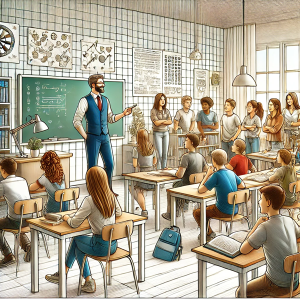Four Practical Ways Teachers Can Teach the Scientific Method

The scientific method is the backbone of scientific inquiry. For teachers, it’s not just about explaining theory—it’s about helping students experience the process themselves. By using interactive examples, experiments, and real-world scenarios, educators can make this method engaging and memorable.
In this guide, we’ll explore scientific method examples for teachers, complete with step-by-step approaches that work in classrooms of all levels.
What is the Scientific Method of Teaching?
The scientific method is a systematic way of exploring questions, testing ideas, and drawing conclusions based on evidence. While the exact number of steps can vary, the classic structure includes:
- Asking a Question – Identifying the problem or curiosity.
- Researching the Topic – Gathering background information.
- Forming a Hypothesis – Making an educated guess
- Designing an Experiment – Creating a testable plan.
- Collecting Data – Recording observations and results.
- Analyzing Results – Determining what the data reveals.
- Drawing Conclusions – Accepting or rejecting the hypothesis.
- Communicating Findings – Sharing results with others.

Four Practical Ways Teachers Can Teach the Scientific Method
1. Use Real-World, Everyday Questions – Detailed Application
When introducing the scientific method, start with a question students can relate to in their daily lives. The more they can connect it to their own experiences, the more invested they’ll be in the outcome.
Example – Plant Growth in Different Light Sources:
Scenario: A student wonders if houseplants grow better in sunlight or under a desk lamp.
Classroom Approach:
- Provide two identical plants in the same type of pot and soil.
- Place one plant near a sunny window and the other under a lamp with a similar light schedule.
- Over several weeks, students record the plant’s height, number of leaves, and overall health.
- Discuss results and connect them to plant biology (photosynthesis, light spectrum).
Real-Life Relevance: Students learn how to care for plants more effectively, apply this to gardening, and understand how lighting affects living organisms.
Why This Works in Teaching:
- It blends curiosity with measurable outcomes.
- Students see immediate progress over time.
- It encourages observation, patience, and record-keeping.
2. Incorporate Hands-On Classroom Experiments – Detailed Application
Hands-on experiments bring the scientific method to life by letting students see and touch the process. Instead of just hearing about variables, hypotheses, and data collection, they get to apply these steps in a real-world context.
Example – Rusting of Metals in Different Liquids
Scenario – Students want to know which liquid will cause a metal nail to rust the fastest—plain water, salt water, or vinegar.
Classroom Approach:
1. Preparation: Gather identical nails or screws, three clear jars, water, salt water (prepared by mixing table salt into water), and vinegar.
2. Step 1 – Hypothesis: Students predict which liquid will rust the nail the quickest and explain their reasoning.
3. Step 2 – Experiment Setup:
* Place one nail in each jar.
* Label the jars clearly.
* Ensure nails are fully submerged.
4. Step 3 – Observation Period:
* Keep all jars in the same location with the same temperature to control variables.
* Record observations daily—changes in color, presence of rust spots, or texture changes.
5. Step 4 – Data Collection:
* Use a table or chart for consistent tracking.
* Take photos as visual evidence.
6. Step 5 – Conclusion:
* Compare rust levels and discuss whether the results match the initial hypothesis.
* Talk about why the winning liquid caused faster corrosion.
Real-Life Relevance:
Students gain an understanding of corrosion, an important concept in engineering, transportation, and construction. They also see why protective coatings or anti-rust treatments are essential in everyday life—especially in coastal areas where salt water is common.
Teacher Tip:
For higher-grade levels, expand the experiment by testing more liquids (lemon juice, soda, oil) or comparing different types of metals. This can introduce advanced topics like pH levels, oxidation rates, and chemical reactions.

3. Encourage Collaborative Learning – Detailed Application
Collaborative projects help students see that science is rarely a solo effort. In real research, scientists often work in teams—sharing tasks, analyzing data together, and discussing results. Group-based scientific method activities mimic this environment, improving teamwork, communication, and problem-solving skills.
Example – Popcorn Kernel Experiment
Scenario: Students want to find out which popcorn brand leaves the fewest unpopped kernels after cooking.
Classroom Approach:
1. Group Setup:
* Divide students into small groups of 3–5 members.
* Assign each group a different popcorn brand to test.
2. Assign Roles Within Groups:
Materials Manager: Collects ingredients and cooking tools.
Timer: Ensures all batches cook for the exact same time.
Data Recorder: Counts and records unpopped kernels.
Presenter: Shares results with the class.
3. Step 1 – Hypothesis:
* Each group predicts which brand will perform best and explains why (price, packaging claims, etc.).
4. Step 2 – Experiment:
* Cook the same quantity of popcorn for each brand using the same method (microwave or stovetop).
* Count the number of unpopped kernels after cooling.
5. Step 3 – Data Analysis:
* Each group calculates the percentage of unpopped kernels.
* Combine all results into a master class chart for comparison.
6. Step 4 – Conclusion:
* Discuss whether brand reputation or price matched actual performance.
Real-Life Relevance:
This activity connects scientific thinking to everyday consumer choices. Students learn how to test marketing claims and make evidence-based purchasing decisions.
Teacher Tip:
For older students, extend the project by calculating cost-per-serving efficiency or testing if different cooking times affect results. This adds a mathematical analysis layer to the scientific method.
4. Connect to Cross-Curricular Learning – Detailed Application
The scientific method doesn’t need to stay confined to science class—it can be integrated into other subjects to create richer, more engaging lessons. This approach helps students see that problem-solving, data analysis, and experimentation are valuable skills across all areas of study.
Example – Water Filtration Project
Scenario: Students are tasked with creating a simple water filter from everyday materials and testing its effectiveness.
Classroom Approach:
1. Materials: Sand, gravel, activated charcoal, plastic bottles (cut in half), coffee filters, and dirty water (made by mixing soil and small debris into clean water).
2. Step 1 – Hypothesis:
* Students predict which filter design will produce the cleanest water.
3. Step 2 – Experiment Design:
* In small groups, students layer materials in different orders to build their filters.
* Pour equal amounts of dirty water into each filter.
4. Step 3 – Observation & Data Collection:
* Record water clarity, filtration speed, and any remaining particles.
* Use visual grading or a turbidity scale for older students.
5. Step 4 – Conclusion:
Compare results to see which design worked best and discuss why.
Cross-Curricular Connections:
Science: Filtration process, particle size, water pollution.
Math: Measuring water volumes and filtration times.
Language Arts: Writing a persuasive essay about the importance of clean water.
Social Studies: Researching water scarcity and solutions in different countries.
Real-Life Relevance:
Students understand the basics of water purification, environmental responsibility, and the importance of access to clean drinking water—valuable both in science and in global awareness.
Teacher Tip:
Encourage students to compare their DIY filters to commercial water filters. For advanced grades, measure pH levels or bacteria count to add a microbiology component.
Hi, I’m Hamid Ali, an MSc in Biotechnology and a passionate Lecturer of Biology with over 11 years of teaching experience. I have dedicated my career to making complex biological concepts accessible and engaging for students and readers alike.
Beyond the classroom, I’m an avid blogger, sharing insights, educational resources, and my love for science to inspire lifelong learning. When I’m not teaching or writing, I enjoy exploring new advancements in biotechnology and contributing to meaningful discussions in the scientific community.
Thank you for visiting my blog! Feel free to connect and explore more of my work.




